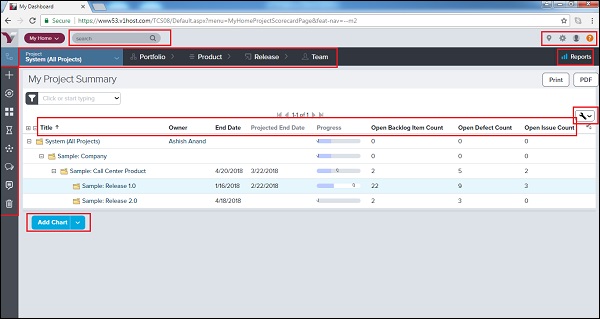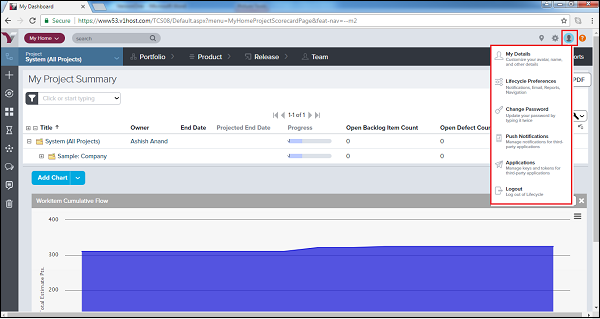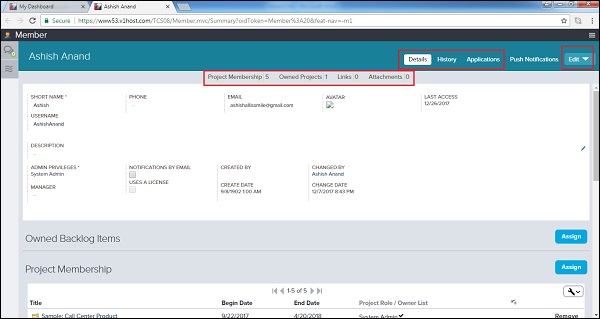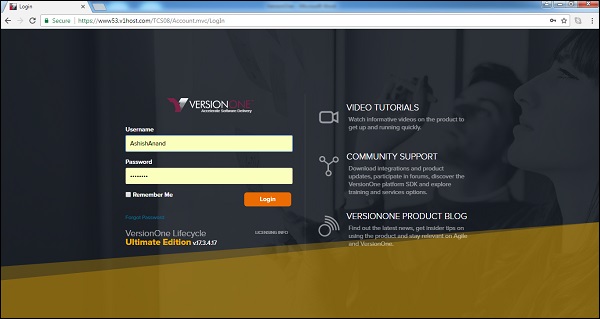
- VersionOne - Home
- VersionOne - Introduction
- VersionOne - Features
- VersionOne - Free Trial Access
- VersionOne - Login
- VersionOne - Dashboard
- VersionOne - Invite Users
- VersionOne - Add a Project
- VersionOne - Portfolio Planner
- VersionOne - Product Planner
- VersionOne - Backlog
- VersionOne - Story
- VersionOne - Edit Story
- VersionOne - Defects
- VersionOne - Edit Defects
- VersionOne - Release Planner
- VersionOne - Sprint Planning
- VersionOne - Sprint Scheduling
- VersionOne - Detail Planning
- VersionOne - Issues
- VersionOne - Task
- VersionOne - Templates
- VersionOne - Import Data
- VersionOne - Team Rooms
- VersionOne - Storyboard
- VersionOne - Testboard
- VersionOne - Taskboard
- VersionOne - Filters
- VersionOne - Search
- VersionOne - Conversation
- VersionOne - Collaboration
- VersionOne - Notification
- VersionOne - Estimably
VersionOne - Dashboard
After logging into VersionOne, a user can navigate to Dashboard where progress of work is summarized and a user can customize reports and matrices as well. A Dashboard is customized by Admin. Based on roles, admin can set the access of VersionOne. Dashboard is similar to homepage that displays all important details and provides links to access of other modules. In this chapter, we will see features and customization of Dashboard.
Points to Note
By default, the Dashboard provides important details about project and the progress. It displays the data for different modules like Project Hierarchy, number of Open Issues, Backlog Count, Defects at project level in the hierarchy. In the following section, we will discuss the important features of Dashboard −
To navigate to the My Dashboard page, click on My Home → My Dashboard link as shown in the screenshot below. It displays the Dashboard page with the default set up.

In the Dashboard page, My Project Summary is located at the top of the page. It shows different metrics to evaluate the state of a project. Filters are also available to search specific projects details. By default, the following fields display for each project −
Project Title
Owner
End Date
Projected End Date
Progress Bars (hover to see Open and Closed Estimates)
Open Stories/Backlog Items
Open Defect Count
Open Issue Count
The navigation bar, present at the top of the page, will be same across all pages/screen of VersionOne Project, Portfolio, Product, Release and Team. The navigation bar has many sub links under each of these links. At the right side of the same navigation bar, Report section is also available. By clicking on these links and sub links, a user can get access to different modules/features supported by VersionOne
Dashboard has different links at the top right. These are same across all pages Site Navigator, Settings, User Profile and Help. These are the static feature of the VersionOne HTML design.
In the extreme left side, it displays few useful shortcut links as Add New Item for Backlog Item, Defect, Story, etc., My Recent Changes to view all recent changes, Rooms, Timesheet, Collaboration, Conversations, Topics and Deleted items. The following screenshot displays the Dashboard of VersionOne −

Add Chart
Dashboard can be customized by adding different available charts to track day to day progress of the project/sprint. A user can add any of the following charts to the My Dashboard page. These charts (displayed at the bottom of the page) help to track progress of the project, sprint/iteration, and team status.
Project Burndown
Sprint/Iteration Burndown
Work item Trend
Defect Priority Trend
Defect Priority Trend
Test Trend
Work item cycle time
Work item cumulative flow
To add a chart, click on the Add Chart button present at the My Dashboard page and select one of the charts as shown in the screenshot below. It displays all available charts to add into the dashboard.

After selection, the chart appears at the bottom of the page as shown below −

User Profile
A logged in user can view his profile in VersionOne. A user with admin role will have access to all users profiles and can edit/update as well. In this section, we will discuss how to view profile and update the details.
By clicking on the Profile icon, a user can view the following options −
My Details − user can view his personal profile as shown below −
It opens the profile details with the edit button on the right side. A user can view History and type of application by clicking on corresponding tab. In details, a user can see Project Membership, Owned Projects, Link and Attachments as well.
The following screenshot displays the user detail page −
Edit the details on this page.

Once a user clicks on the Edit button, the user details open in a new window in the edit mode. A user can change the details and click on Save to save the changes as shown below −

Lifecycle Preferences − A user can select Navigation, Email forwarding options, Event Notifications and Report Settings as shown in the screenshot below −

Change Password − Using this option, user can change the current password and set a new one.
Push Notifications − It manages notification from third party applications.
Applications − It manages keys and tokens from third party applications.
Logout − By clicking on Logout, a user will be get back to the login page and will not be able to access project details without logging in back as shown in the screenshot below.
